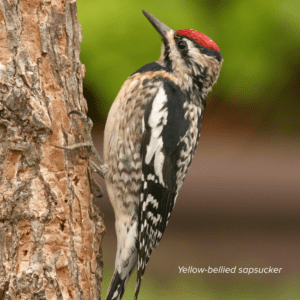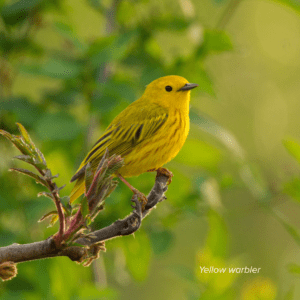
Building a “Birdport”: Migrations, Habitats, and a Billion Small Miracles
Spring has come to The Parklands, and with it, many changes. The flights of migrating birds are especially wondrous. Literally billions of birds, and hundreds of species, move northwards to the warming landscapes of the U.S. and Canada, with their swarms of insects and small mammals, and abundant spaces for breeding. This annual influx really has no equal, both in the number, the consequences, the beauty, and the fact that it largely escapes our notice, even as it passes through our parks and yards daily for about two months from early April to early June.
A map of air travel for migrating birds
The flight paths of migrating birds and their ground activities are much like what you might see at a major airport, say, New York’s LaGuardia or Atlanta’s Hartsfield-Jackson. Think of an air route map with lines soaring up from distant destinations and points of origin, all centered on their runways. Substitute bird species for airlines, and you have a pretty good analogy for what’s happening in The Parklands and our neighborhoods.
Here are just a few examples of the routes migrating birds follow:
 The Ruby-throated hummingbird. At just 3.2 grams (0.1 ounces), it flies nearly 2000 miles each way (north in the spring, back south in the fall) from southern Mexico and Central America to Canada, including over 500 miles above the water from the Yucatan Peninsula to the southern U.S.
The Ruby-throated hummingbird. At just 3.2 grams (0.1 ounces), it flies nearly 2000 miles each way (north in the spring, back south in the fall) from southern Mexico and Central America to Canada, including over 500 miles above the water from the Yucatan Peninsula to the southern U.S.
The Broad-winged hawk. At the other end of the size spectrum, the Broad-winged hawk travels from the eastern U.S. and southern Canada all the way down to southern Brazil and northern Columbia.
The Barn Swallow. In between is this more recognizable species, weighing in at 20 grams/0.7 ounces. Besides being the most abundant and widespread swallow in the world, this species flies an astonishing 3000-5000 miles from as far north as Alaska to the southern tip of South America.
Not only are their distances amazing, but they move through, and survive in, habitats as diverse as the Canadian boreal forest and tundra, the hardwood forests of the eastern U.S., and the tropical forests in Brazil, Mexico, and Central America.
The Parklands to date has recorded almost 200 different species within its borders since we opened a decade ago. Since a large portion of them are migrants of some kind, you can imagine birds as planes on an air route diagram.
 Migrants to The Parklands include a number of different seasonal groups:
Migrants to The Parklands include a number of different seasonal groups:
- Northern species who winter here such as the Yellow-bellied sapsucker, the White-throated sparrow, the Brown Creeper, and many more
- Southern species who spend the winter in warmer climates but return to The Parklands to breed include Kentucky and Prothonotary warblers, many swallow species, Indigo buntings, and Blue grosbeaks
- There are also layover species, who stop for a few days to recharge from their long and exhausting journeys before going on to the next leg north
This high concentration of birds derives from our position as a long band of green on the edge of a large urban area. Since most migrants fly at night, come morning they are seeking a place to land, with food, plants and trees, cover, and water, all of which The Parklands provides in abundance. It is not, however, an accident that we host such a high diversity of species throughout the year.
Creating spaces for birds to land
So, before we get to the aeronautical wonders we humans call birds, let’s explore how The Parklands supports them on their journey by creating critical spaces for them (by analogy, the “airport”).
Stepping back for a moment, one might ask, “How do you build an airport (“a birdport”) for birds?” It turns out it’s quite different from one built for planes (no surprise there) and that it’s also somewhat complex, since you’re working with nature’s tools and on nature’s timetable, managing natural cycles from years to centuries.
This is where the design of The Parklands becomes important.
Parks provide spaces for both people and nature. We are all familiar with human spaces such as playgrounds, lawns, bike paths, and trails. Less obvious are the spaces we’ve created for the other creatures who inhabit The Parklands, but our designs are just as thoughtful and just as intentional.
Birds, like all animals, are creatures of habit and habitat. While many people think the most diverse habitat is an old growth forest, biodiversity actually derives from a mix of habitats, as each landscape hosts a unique set of species. Add them up together, as we’ve done in The Parklands, and you create homes for dozens of bird species, and temporary shelter for the hundreds more species who migrate through in the spring and fall.
To maximize their diversity on a landscape, you must maximize the habitats present, and our plan (what we call the “100 Year Vision”) does just that.
Since our inception, we acquired over 80 separate real estate parcels while assembling The Parklands, each of which had a different land use history and different future ecological trajectory.
Designing our natural areas plan meant redirecting those many different ecologies into one larger vision. Our goal was to connect people with an authentic Kentucky natural landscape and to attract and support a wide diversity of plants and animals. That diversity is intentional and has proven effective, based on our attractiveness to such a wide array of bird species.
Aeronautical wonders from Sparrows to Virginia Rails
So how does that all work? By following Floyds Fork, we create paths (think “runways” and “hangars”) for specific birds such as the Great Blue Heron or the Kingfisher, who build nests in its trees (the herons) and in holes in its banks (the kingfisher).
By restoring meadows, we provide habitat and food for a host of other bird species from sparrows to warblers to buntings. In the chill of a late February dusk, you can hear and sometimes see the dozens of American woodcocks, once hunted nearly to extinction, perform their aerial mating rituals in our restored meadows.
Shrubby areas, such as those around the Humana Grand Allee wetlands, provide cover for many birds—a fun one there is the Wilson’s snipe (look it up!)—while the wetlands with their cattails do the same. A reclusive group of migrating birds known as the Rails has been spotted there during migration. These include both Soras and Virginia Rails.
Finally, large blocks of mature forest offer temporary shelter for migrants and breeding sites for residents. Even our dying trees provide food, through the insects who feed there, and homes for the many cavity nesters from Wood Ducks to woodpeckers (the Red-headed, the Red-bellied, Downy, the Hairy, and the Pileated), and surprisingly, even a warbler (the Prothonotary).
 The arrival of the warblers
The arrival of the warblers
All of this is just an introduction to what many consider the climax of the spring bird migrations in the eastern United States: the arrival of the Wood Warblers, with their brilliant colors and musical songs. Over 30 species have the potential to pass through The Parklands in the peak period of late April to mid-May, and about a third of those will nest in or near The Parklands.
These warblers attract notice first from their songs. While hard to learn individually, even knowing a couple of their songs will introduce you to this world of avian music (the Yellow warbler and Common Yellowthroat are good starters). Set up the Merlin Bird ID app by Cornell Lab on your phone to help identify them.
When you catch a glimpse of the black mask of the Common Yellowthroat or the brilliant orange head of the Blackburnian, you will understand the attraction of birders to these amazing creatures.
These birds become even more captivating when you consider the routes they took to get here and the many landscapes they had to learn to arrive. The Blackburnian warbler spends its winters in the Andes Mountains, the Common Yellowthroat in the southern U.S., Mexico, and Central America. One of their most fascinating characteristics is that we only see about a third of their lives here in the summer. They have a completely different life—different foods, different habitats, and different plant, animal, and bird species around them.
Experience a true phenomenon
There is really no other natural phenomenon quite like it. The word “miracle” is often overused but if you study neotropical migration there’s no better word to describe it. The word becomes particularly apt when you consider the complexity and astonishing feats of endurance and flexibility involved in the process, along with the continued mystery of its evolution, its drivers and physiology and routes that are only recently beginning to be unraveled by science.
During The Parklands Spring, we get just a moment to see and hear and connect with these travelers in all their diversity. As one friend exclaimed with astonishment when told this story: “How could I have lived here my whole life and never looked up?”
Please take a moment in the coming weeks to take a walk through any of The Parkland’s habitats and just pause to listen and look. If you have a pair of binoculars, that’s great, but you don’t need them with our Bald Eagles, Broad-winged hawks, or Baltimore orioles, or even many of the warblers, who may perch just a few feet in front of you singing away. Come experience spring at The Parklands!
 Additional resources
Additional resources
Area and regional parks. The Parklands is a great place to watch and listen for birds due to its habitat diversity, accessibility, and ADA-accessible paths, but there are many places in Louisville and surrounding areas to enjoy birding.
In Louisville, all of the Olmsted Parks are wonderful, as is Caperton Swamp on River Road*, as well as numerous neighborhood Metro Parks. Surrounding Louisville, Bernheim Forest and Red River Gorge are fun day trips and great places to hike while birding.
Across the river in Indiana, The Falls of the Ohio, Brown County State Park, and Muscatatuck National Wildlife Refuge all expand the number of habitats available to find additional bird species.
*Note: At the time of publishing, restoration efforts were underway at Caperton Swamp following recent flooding of the Ohio River. This park area is also now impacted by a major infrastructure improvement project along River Road.
Birdwatching apps and books on bird migration. The app “Merlin,” mentioned above, is free, and will clue you in to birds you might not be seeing, but which are present. The Sibley bird app (not free) brings the best birding guide you can buy to your phone and your fingertips.
One book I’ve enjoyed is Kenn Kaufman’s “A Season on the Wind: Inside the World of Spring Migration,” which focuses on midwestern birds so highly relevant to The Parklands. Another is Scott Weidensaul’s “A World on the Wing: The Global Odyssey of Migratory Birds,” which takes you to the bigger story and offers in-depth explanations of many of the scientific mysteries and discoveries behind these incredible journeys.
